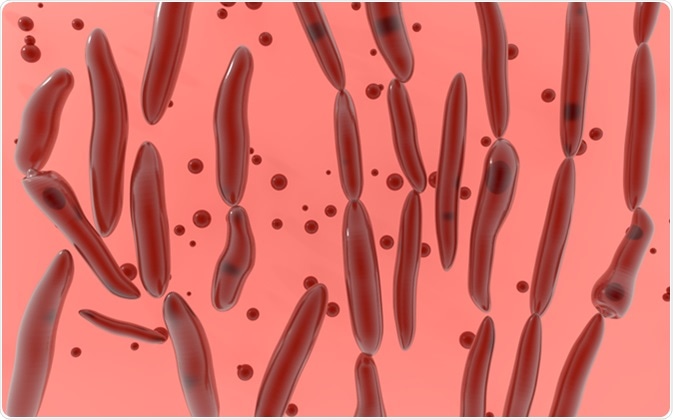Clostridium botulinum is a relatively large, Gram-positive, spore-forming rod bacterium that grows best in an anaerobic environment at around pH 5 and produces a potent neurotoxin.
The endospores produced by C. botulinum are heat resistant and often contaminate food. These spores can germinate and the bacteria begin to grow in food, which is most prevalent in unheated canned food.

Clostridium botulinum bacterium 3d illustration. Image Credit: MZinchenko / Shutterstock
Clostridium botulinum replication
C. botulinum is mainly found in soil and freshwater sediments. The spores of the bacteria can also live in various foods due to their chemical and heat resistant nature. C. botulinum replicates by binary fission.
C. botulinum DNA contains a circular chromosome. DNA helicase unwinds the DNA on the leading strand and replication continuously occurs in a 5’ to 3’ direction. On the lagging strand, replication occurs by the discontinuous joining of Okazaki fragments. DNA polymerase, a sliding clamp, a clamp loader, and DNA primase all act on the leading strand to facilitate DNA replication. DNA ligase can join the DNA as it is being synthesized.
Once the new DNA circle is synthesized, C. botulinum can undergo splitting. This involves the two separate DNA circles moving towards opposite ends. Once they have been separated, a septum is formed and the cell pinches to create two separate bacteria.
Pathogenesis of Clostridium botulinum
Botulinum toxin blocks acetylcholine neurotransmitter release, which prevents muscle stimulation. This causes nausea, vomiting, headaches, double vision, and other neurological symptoms. Eventually, flaccid paralysis occurs, which can result in death due to respiratory and cardiac failure.
There are 3 types of botulism:
The botulinum toxin is a simple A-B toxin with a binding domain (B) and an enzymatic domain (A). There are 8 serotypes of botulinum toxin: A-H. The toxin binds to gangliosides receptor and is internalized. Each serotype cleaves a different part of the SNARE proteins that are responsible for the release of acetylcholine into the synapse from vesicles.
- B, D, F, and G serotypes cleave synaptobrevin
- A and E serotypes cleave SNAP-25
- C serotype cleaves SNAP-25 and syntaxin-1.
- H has yet to be characterized, but is like F so may cleave synaptobrevin.
C. botulinum can exist in many environments and in many foods. The spores can survive harsh conditions and germinate to allow the bacteria to grow. Replication of C. botulinum is achieved through binary fission, allowing the population to grow at an exponential rate.
The neurotoxin released by C. botulinum is extremely potent and can lead to serious health complications.
More research into the life cycle of C. botulinum will allow for a better understanding of the processes of its replication, colonization, and pathogenesis. These information will allow for better prevention and treatment of botulism.
Further Reading
Last Updated: Feb 26, 2019